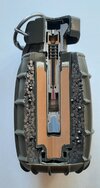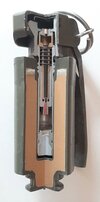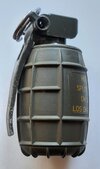Cutaway model of a German HGR (HandGRanate) Splitter DM51 handgrenade , fuzed with the handgranatenzunder DM82. This handgrenade was designed in the 70’s of the last century and taken into service of the Bundeswehr (German army) in 1978 with the special feature that it could function as an offensive and a defensive grenade.
The Diehl company designed a handgrenade that is delivered as a defensive grenade, but can be changed to an offensive grenade by twisting the bottom cap, thereby releasing the bayonet lock at the base of the explosive container, allowing the explosive container to be removed from the fragmentation sleeve. All parts of the grenade body are plastic made, exept for the 2mm dia. hardened steel balls in the fragmentation sleeve, which are cast in resign.
The fragmentation sleeve contains appr. 6500 hardened steel balls. If a hardened aluminium plate 2mm thick and 1x1 meter square is placed 3 meters from the grenade, 83 penetrations are observed after the grenade has exploded.
The explosive container houses 59 grams explosive 812, called Pentastit, mixed with wax as a phlexmatizer 93:7.
The fuze used on the grenade is the handgranatenzunder (grenade fuze) DM82. The fuze uses the normal mouse trap firing pin mechanism to ignite the fuze when the lever is released. Inside the fuze , a brass pipe houses the pyrotechnic fuze (black). The pipe is connected to the fuze body with a roll seam. Around this brass pipe, a steel pipe housing the heat sensitive detonator (red) at the base is soft soldered in place. A spring above the steel detonator housing wants to push it downward into the booster at the base of the fuze.
As depicted here, the heat sensitive detonator (red) cannot detonate the booster charge at the base of the fuze as the distance is too large, it has to be pushed into the booster charge and make contact with the booster charge to be able to detonate the booster charge.
If the lever of the grenade is released the mouse trap mechanism ignites the firing cap which ignites the pyrotechnic fuze. The fuze starts burning and as it passes the soldered part the heat will melt the solder, allowing the spring to push the steel detonator housing downward , the heat sensitive detonator in the booster charge. If the pyrotechnic fuze burns through it sends a flame into the detonator which ignites the booster charge, which ignites the main charge.
Length defensive grenade (with fragmentation sleeve) : 107mm
Length offensive grenade (without fragmentation sleeve): 100mm
Diameter defensive grenade : 57mm
Diameter offensive grenade, measured over the corners of the hexagonal body : 37mm
Weight defensive grenade : 450 gram
Weight offensive grenade : 154 gram
Explosive charge : 59 gram pentatstit
Regards, DJH
The Diehl company designed a handgrenade that is delivered as a defensive grenade, but can be changed to an offensive grenade by twisting the bottom cap, thereby releasing the bayonet lock at the base of the explosive container, allowing the explosive container to be removed from the fragmentation sleeve. All parts of the grenade body are plastic made, exept for the 2mm dia. hardened steel balls in the fragmentation sleeve, which are cast in resign.
The fragmentation sleeve contains appr. 6500 hardened steel balls. If a hardened aluminium plate 2mm thick and 1x1 meter square is placed 3 meters from the grenade, 83 penetrations are observed after the grenade has exploded.
The explosive container houses 59 grams explosive 812, called Pentastit, mixed with wax as a phlexmatizer 93:7.
The fuze used on the grenade is the handgranatenzunder (grenade fuze) DM82. The fuze uses the normal mouse trap firing pin mechanism to ignite the fuze when the lever is released. Inside the fuze , a brass pipe houses the pyrotechnic fuze (black). The pipe is connected to the fuze body with a roll seam. Around this brass pipe, a steel pipe housing the heat sensitive detonator (red) at the base is soft soldered in place. A spring above the steel detonator housing wants to push it downward into the booster at the base of the fuze.
As depicted here, the heat sensitive detonator (red) cannot detonate the booster charge at the base of the fuze as the distance is too large, it has to be pushed into the booster charge and make contact with the booster charge to be able to detonate the booster charge.
If the lever of the grenade is released the mouse trap mechanism ignites the firing cap which ignites the pyrotechnic fuze. The fuze starts burning and as it passes the soldered part the heat will melt the solder, allowing the spring to push the steel detonator housing downward , the heat sensitive detonator in the booster charge. If the pyrotechnic fuze burns through it sends a flame into the detonator which ignites the booster charge, which ignites the main charge.
Length defensive grenade (with fragmentation sleeve) : 107mm
Length offensive grenade (without fragmentation sleeve): 100mm
Diameter defensive grenade : 57mm
Diameter offensive grenade, measured over the corners of the hexagonal body : 37mm
Weight defensive grenade : 450 gram
Weight offensive grenade : 154 gram
Explosive charge : 59 gram pentatstit
Regards, DJH
Attachments
Last edited:



